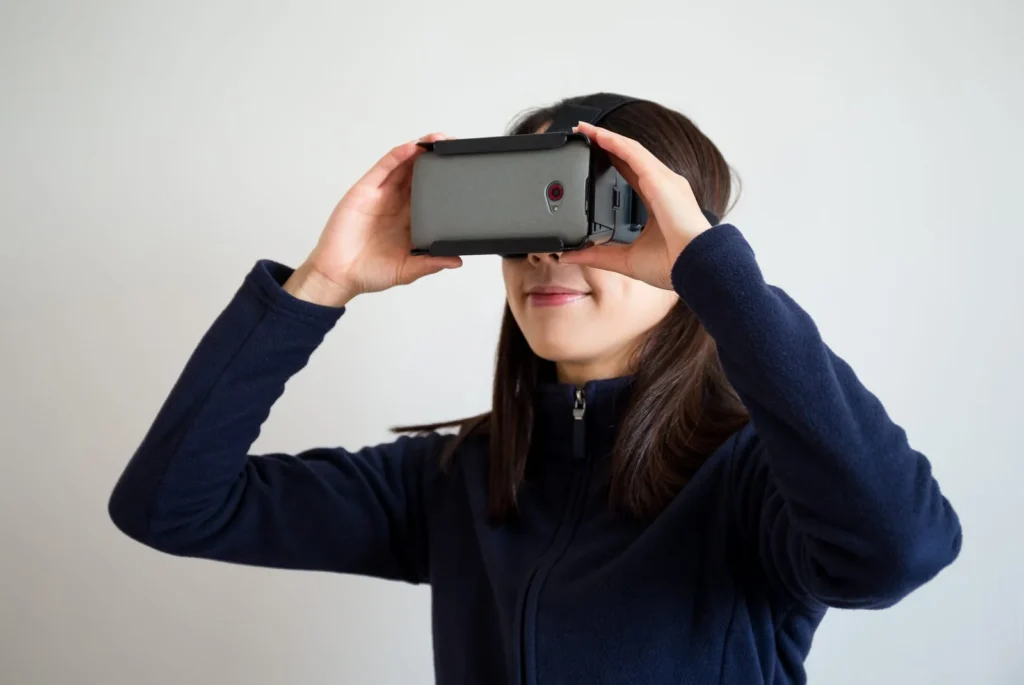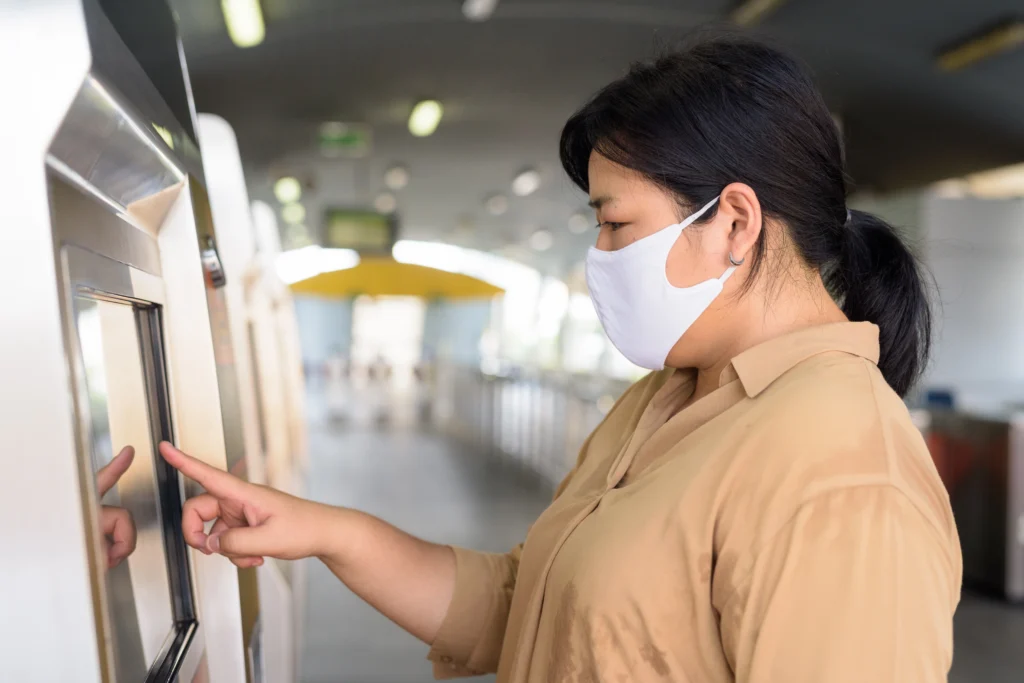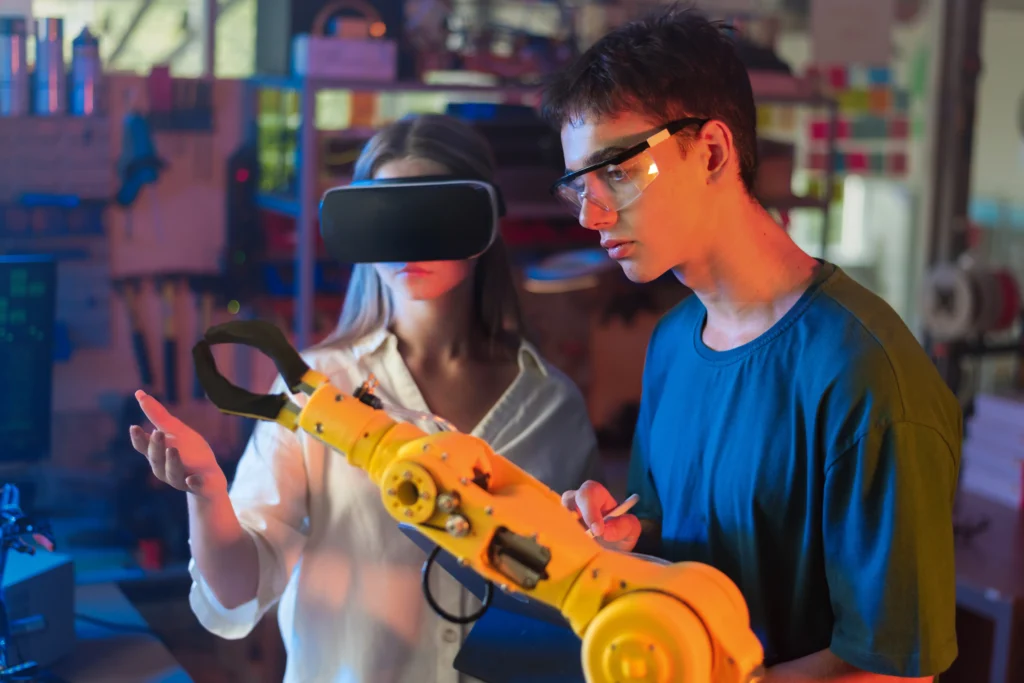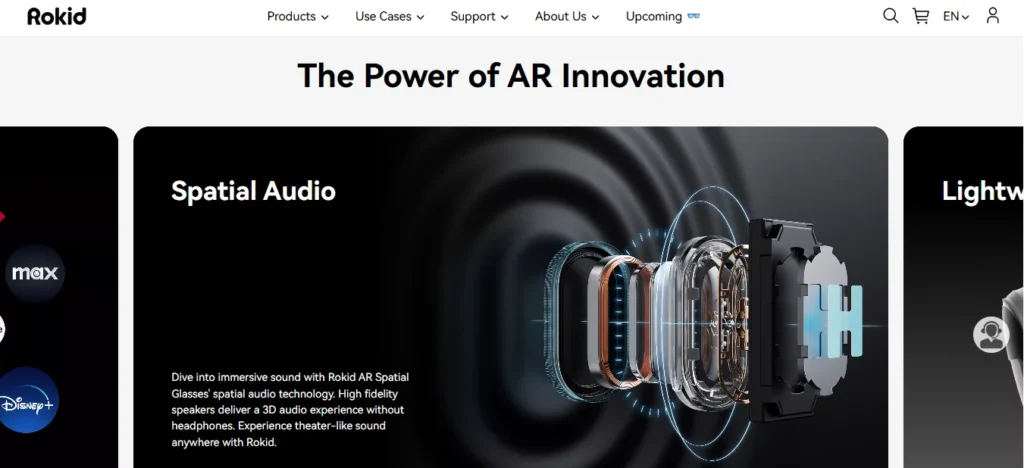China’s XR for business sector has entered a decisive phase. What began as scattered VR and AR pilots is now an integrated national push—spanning 5.5G networks, cloud rendering, AI-driven spatial computing, and industrial digitization.
Unlike Western markets, China’s XR strategy is anchored in policy, not hype. Ministries such as the MIIT and the National Development and Reform Commission have linked XR to manufacturing transformation, digital education, and smart city development.
In 2025, the government aims to cultivate over 10 “backbone enterprises,” establish public XR service platforms, and deploy large-scale demonstration projects across healthcare, culture, and industrial training. Meanwhile, players like ByteDance’s PICO, XREAL, and telecom giants are driving commercialization through affordable hardware, telco bundles, and cross-sector pilots.
China’s XR expansion follows a unified model in which policy direction, telecom infrastructure, and industrial deployment evolve in tandem. This alignment views XR not as a standalone gadget trend, but as digital infrastructure driving productivity across manufacturing, education, healthcare, and smart-city programs.
Definitions, Stack, and China-Specific Nuances

Understanding XR Technologies
Extended Reality (XR)—encompassing Augmented Reality (AR), Virtual Reality (VR), and Mixed Reality (MR)—has become a strategic frontier in China’s digital economy. Authorities and industry leaders now treat XR as foundational infrastructure for the immersive fusion of online and offline economies.
Shanghai’s Lingang Free Trade Zone exemplifies this approach. Its 2023–2025 plan targets an XR industry scale exceeding ¥100 billion (US$14 billion) and the deployment of over one million XR terminals by 2025. National telecoms echo this vision: China Mobile’s chairman calls AR/VR “key entry points” that connect the physical and digital worlds across entertainment, tourism, and enterprise collaboration.
The consumer market reflects this momentum. In 2024, China’s XR device shipments reached 536,000 units, with AR overtaking VR for the first time. AR accounted for 61 percent of online XR sales, while VR fell to 39 percent.
Domestic leaders such as XREAL, Rokid, PICO, and Huawei dominate this surge—XREAL alone now holds roughly 58 percent of the global XR headset market. During the 2023 “Double Eleven” festival, JD.com reported that AR glasses sales were up four times year-over-year, illustrating mainstream adoption beyond early enthusiasts.
In short, China’s XR growth is anchored in two key trends: state-backed industrial policy and a rapid shift in consumer demand toward lightweight, mixed-reality devices. For marketers and developers, this signals a maturing audience that is already comfortable with 3D and interactive experiences.
China’s XR Technology Stack
China’s XR stack diverges from Western models through deep integration of policy, telecom, and localized engineering.
- Device Layer – Hardware ranges from AR glasses and MR headsets to motion sensors. Innovation focuses on optical waveguides, low-power chips, and smartphone-tethered devices, such as the XREAL Beam Pro, optimized for affordability and weight reduction.
- Perception & SLAM – Domestic chipmakers power spatial tracking and depth sensing through visual-inertial fusion and AI-based mapping, ensuring independence from foreign components.
- Rendering & Compute – Heavy workloads are moved to cloud GPUs and telco-edge nodes, enabling high-fidelity rendering on budget hardware while meeting local data-residency requirements.
- Network Layer – The rollout of 5.5G (5G-Advanced) delivers sub-10 ms motion-to-photon latency and stable uplinks for multiuser XR sessions.
- Application Layer – Platforms like ByteDance XROS, Huawei XR OS, and Tencent Cloud XR support enterprise, education, and retail visualization apps—often co-funded under provincial pilot programs.
Localization and Policy Integration
China follows a “standards-first” principle (标准先行). The Ministry of Industry and Information Technology (MIIT) coordinates interoperability rules for optics, tracking, and cloud rendering so all vendors align with unified network and data protocols. This alignment allows seamless integration into national 5.5G grids and public cloud-edge systems.
This coordination model is now visible in execution, as ministries, telecoms, and hardware makers co-develop pilots under unified standards, reflecting the early national blueprint for XR development.
Extended Reality (XR), encompassing Augmented Reality (AR), Virtual Reality (VR), and Mixed Reality (MR), has become a strategic frontier in China’s technology and marketing landscape. Chinese authorities and industry are aggressively investing in XR as a pillar of the digital economy.
Why XR for Business Is a Strategic Marketing Tool

China’s leading marketers see XR not as a gimmick, but as a new medium for deepening customer engagement and brand experience. XR extends marketing from flat screens into immersive, interactive scenarios.
In the AI-driven era, Chinese advertising giants predict a convergence of AI and XR as the basis of “next-generation digital content marketing.” As one analyst puts it, AI (especially generative AI) will dramatically lower the cost of creating XR content and make it more interactive, enabling users to engage with AI-driven virtual assistants or avatars in a rich environment
The business promise is multi-fold:
Immersive Engagement
XR can “overlay” digital stories onto real environments. Brands can transport customers into virtual showrooms, product demos, or storytelling experiences that stand out from standard ads. For example, theme-park–style VR showrooms or AR try-on mirrors allow consumers to “experience” products (cars, cosmetics, furniture) before buying.
Personalization & Data
Integrated with 5G and AI, XR experiences can adapt in real-time to each user’s preferences or movements, enabling ultra-targeted advertising. (83.5% of AR revenue in 2024 came from advertising, reflecting XR’s strength in precise, scenario-based ads.)
New Brand Storytelling
XR fosters creative content that traditional channels can’t match. Virtual influencers, digital avatars, and gamified campaigns capture younger audiences. Chinese marketers are already deploying “virtual digital humans” as brand ambassadors – building their own IP instead of paying celebrities.
For instance, BlueFocus (a top Chinese PR agency) created “Su Xiaomei”, a virtual digital person, to serve as a tourism ambassador for Chinese cultural sites.
Unlike a hired star, “Su Xiaomei” is a branded IP that can appear in social media, AR filters, livestreams, or events, allowing the region to tell its story and engage fans continuously. The agency argues every brand should have its own virtual persona – an “animation character” – to craft stories and build loyalty.
Integrated Online–Offline Channels
XR blurs the lines between digital and physical marketing. For example, telecom operator China Mobile has integrated “AI+XR” experiences into its retail outlets: customers wearing AR/MR glasses can tour virtual exhibits (from Dunhuang cave murals to cosmic simulations) within stores, turning sales outlets into immersive showrooms.
This digital-physical fusion also extends to events: China Mobile’s 2025 partner conference featured XR “big space” booths where visitors freely chose different themed VR journeys, demonstrating how XR can enrich live brand events and tie physical presence to virtual content.
Key Drivers: Broadly, Chinese CMOs invest in XR to reach digitally-savvy consumers (Gen Z and beyond), to stand out in a crowded media landscape, and to gather richer engagement metrics. The simultaneous rise of cloud AI, 5G/6G networks, and XR hardware creates an environment where immersive marketing is not just feasible but highly scalable.
As China’s mobile tech chief noted, smart glasses and AR/VR will become “the key entrance linking digital and physical worlds,” underlining why companies view XR as an essential channel for the future.
Why 5.5G + Cloud Rendering Changes Unit Economics

The Backbone of China’s XR Scalability
China’s 5.5G rollout is transforming XR from a bandwidth-heavy curiosity into a scalable service. 5.5G, often branded domestically as 5G-Advanced, upgrades latency, throughput, and energy efficiency to support real-time 3D rendering, multiuser AR, and holographic communication.
For XR developers and operators, this shift is financial—not just technical. It redistributes processing costs from headsets to the network, allowing devices to become cheaper, lighter, and more widely deployable.
What 5.5G Actually Delivers
According to China Mobile’s latest field trials, 5.5G networks can achieve:
- Uplink speeds exceeding 1 Gbps are critical for multi-angle video capture and spatial mapping.
- End-to-end latency under 5 ms for motion-to-photon loops.
- Deterministic networking with quality of service slicing, ensuring stable frame delivery even under public network load.
China Unicom and Huawei jointly launched the “XR + Cloud Network Integration” framework in 2024, which defines how base stations allocate compute resources dynamically based on the priority of XR applications. This enables seamless transitions between edge nodes, minimizing jitter during user movement—a persistent barrier in traditional 5G networks.
Cloud Rendering as a Cost Equalizer
Cloud rendering—the remote generation of 3D environments streamed to lightweight terminals—is now at the center of China’s XR cost model. By 2025, over 60 percent of industrial XR applications are expected to rely on cloud-rendered content. This approach eliminates the need for high-end GPUs in headsets and reduces the bill of materials costs by 40–50 percent.
Telecom operators provide Rendering-as-a-Service through nationwide GPU pools integrated with China Telecom’s Tianyi Cloud and China Mobile’s Migu Cloud XR. For example:
Platforms like China Mobile’s Migu XR Cloud and China Telecom’s Tianyi Cloud XR offer per-minute rendering at rates between ¥0.7 and ¥1.0, converting one-time capital expenses (CapEx) into predictable operating expenses (OpEx).
The Guangzhou 5.5G Innovation Zone pilot reported an 18% drop in rendering cost per session and a 27% improvement in user quality-of-experience (QoE) once AI-driven edge scheduling was deployed.
Tencent Cloud XR Stack offers SDKs for developers to offload 3D environments directly to regional data centers, enabling low-latency rendering across provinces.
This model generates predictable operating expenses (OPEX) rather than requiring significant upfront hardware investments, thereby accelerating adoption in sectors such as manufacturing, education, and public safety.
Network Economics and Telco Bundling
The combination of 5.5G and cloud rendering is shifting revenue structures for operators. Instead of selling bandwidth, telcos now package XR service bundles that include connectivity, rendering capacity, and content access.
- China Mobile’s “XR Pass” charges enterprises a monthly fee per connected device, including bandwidth guarantees and rendering credits.
- China Unicom’s Industrial XR Package integrates XR traffic into private network slices for factories, ensuring secure internal data flow.
For end users, this turns XR into a subscription-based service—closer to streaming economics than hardware sales. For vendors, it guarantees recurring revenue while reducing entry costs for SMEs.
Edge Intelligence and Latency Optimization
To sustain national deployment, edge nodes are being equipped with AI-driven traffic scheduling. These algorithms predict motion paths, prioritize 3D asset preloading, and allocate bandwidth dynamically to maintain consistent frame rates. In pilot tests at Guangzhou’s 5.5G Innovation Zone, such optimization reduced average rendering cost per session by 18 percent and improved QoE scores by over 25 percent.
The broader implication: XR’s success in China now hinges as much on telecom and compute infrastructure as on optics or content. Whoever controls the cloud-edge rendering layer effectively controls access to XR monetization.
From Headsets to Glasses: China’s Hardware Transition
China’s XR hardware evolution is diverging from the West’s “all-in-one headset” model. The domestic market is shifting toward lightweight, phone-tethered AR glasses and mixed-reality displays optimized for comfort and battery efficiency. Instead of competing on pixel density alone, Chinese OEMs compete on integration efficiency — how well optics, compute, and connectivity align with local 5.5G and AI ecosystems.
This shift reflects two strategic priorities: lowering cost per unit to expand consumer reach, and synchronizing with state goals for industrial and educational deployments where long wear time and real-world mobility matter more than raw immersion.
Key Players Defining the Market
XREAL (formerly Nreal)

XREAL has become China’s breakout XR hardware champion, now controlling an estimated 58 percent of the global AR headset market. Its flagship models, such as XREAL Air 2 Ultra and the Beam Pro, use a smartphone-linked architecture that offloads heavy compute tasks to the phone or cloud.
- Core differentiation: a dual-camera SLAM system enabling full six-degree tracking without dedicated controllers.
- Strategic edge: seamless integration with domestic app ecosystems (Bilibili, Douyin, and local cloud-gaming platforms) and compliance with MIIT’s rendering standards.
XREAL’s design philosophy—“phone-as-brain, glasses-as-display”—embodies China’s pragmatic route toward mass adoption through affordability and comfort.
ByteDance’s PICO
After major restructuring in 2024, ByteDance repositioned PICO 4 Ultra from a consumer gaming headset to a platform for enterprise and social content. PICO now prioritizes productivity and immersive meeting software built on XROS, ByteDance’s proprietary operating system.
The company leverages its Douyin data and recommendation algorithms to personalize 3D environments and advertising spaces within XR.
- ByteDance’s advantage lies in distribution: Douyin’s 700 million daily active users provide an unmatched funnel for XR content and e-commerce integration.
- PICO devices are being bundled with China Mobile’s 5.5G service plans, bridging hardware sales with telco-backed connectivity packages.
Rokid
Rokid focuses on industrial and educational AR, supplying ruggedized smart glasses to manufacturing and field-service companies. Its devices emphasize durability, localized language processing, and integration with government-approved training and inspection platforms.
Huawei
Huawei treats XR as an extension of its device ecosystem. Its Vision Glass series and AR Engine 5.0 embed XR capabilities directly into HarmonyOS, aligning hardware, OS, and telco infrastructure into a single, vertically integrated system.
Its 2024 functional tests confirmed end-to-end XR transmission latency below 5 milliseconds and uplink speeds exceeding 1 Gbps—key for high-density 3D scenes and multi-angle spatial mapping. These tests also validated QoS slicing, which dynamically allocates network resources based on XR traffic priority, ensuring stable motion tracking even under high user load.
Huawei’s 泛XR产业发展白皮书 further emphasizes that over 60 percent of China’s industrial XR applications will rely on cloud rendering by late 2025, using telecom GPU pools rather than local GPUs. This approach eliminates the need for costly onboard processors, reducing headset bill of materials (BOM) by 40–50 percent and enabling rapid mass production.
Component Independence and Supply-Chain Strategy
China’s XR competitiveness now depends on reducing reliance on imported core components—particularly optical engines, micro-OLED displays, and high-precision sensors. The Ministry of Science and Technology has funded national projects to scale domestic suppliers such as Jade Bird Display, Goertek, and O-Film.
These firms are achieving yield improvements in waveguide optics and LCoS microdisplays, closing the gap with Japan and Korea. Such localization is crucial for meeting export-control constraints and ensuring stable pricing.
Ergonomics, Optics, and Market Differentiation
The new generation of Chinese devices focuses on wearability over spectacle. XREAL Air 2 Ultra weighs only 120g, compared to 600 g or more for older all-in-one VR units. Waveguide optics and dual-hinge temples provide all-day usability, aligning with educational and industrial pilots that require multi-hour sessions.
Manufacturers are also experimenting with adjustable transparency—allowing users to shift from AR overlays to immersive MR—an area where Chinese optics labs are making measurable progress. These innovations reduce visual fatigue and motion sickness, two historic barriers to the mainstream use of XR.
Why Hardware Is China’s Strategic Lever
Hardware remains China’s strongest differentiator because it controls both distribution economics and data sovereignty. By dominating optical and sensor manufacturing, China not only drives down costs but also anchors its domestic XR ecosystem within national security and export-compliance parameters.
The outcome: XR in China isn’t built around one killer app; it’s built around an integrated supply chain that ensures resilience, cost efficiency, and interoperability with national 5.5G and AI infrastructures.
The shift from heavy, all-in-one headsets to lightweight, phone-tethered AR glasses has transformed XR from a lab prototype into a deployable enterprise tool. Affordable, ergonomic devices now make long training sessions, field operations, and retail interactions commercially viable.
This hardware maturity is unlocking measurable results across multiple industries—where XR is no longer a demo, but a driver of operational efficiency and revenue growth.
Five Verticals with Repeatable ROI
Unlike in Western markets, China’s XR adoption isn’t waiting for consumer enthusiasm—it’s being driven by enterprise deployment and measurable efficiency gains. Ministries and major SOEs evaluate XR by hard metrics: defect reduction, productivity improvement, and learning retention. Here’s where those results are already visible.
1. Manufacturing and Energy
Core Use: remote guidance, digital twin monitoring, and assembly-line training.
Industrial XR adoption is strongest in automotive, aerospace, and energy sectors. For instance:
- SAIC Motor utilizes AR headsets for line inspection and remote diagnostics, resulting in a 27 percent reduction in downtime.
- Sinopec’s XR Safety Training Platform, deployed in over 100 plants, cut accident rates in pilot areas by 18 percent within a year.
- 5.5G-enabled “mirror factories” link live operations with virtual models to simulate maintenance or repair before execution.
This use case is now part of the MIIT’s “Industrial Internet + XR” initiative, which subsidizes equipment purchases for certified factories.
2. Healthcare and Medical Training
Core Use: surgical planning, AR-guided operations, and patient education.
Top-tier hospitals, such as Peking Union Medical College Hospital and Ruijin Hospital (Shanghai), employ XR for preoperative simulations and resident training.
- Mixed reality tools allow surgeons to visualize 3D vascular maps over real anatomy, improving precision in laparoscopic procedures.
- AI-assisted AR overlays from firms like Shanghai United Imaging enhance radiology interpretation in teaching hospitals.
By 2025, at least 50 medical institutions will operate under the Smart Healthcare XR Demonstration Program, co-funded by MIIT and the National Health Commission.
3. Education and Vocational Training
Core Use: immersive classrooms, skill certification, and campus metaverse experiences.
XR integration in education aligns directly with China’s Digital Campus 3.0 plan.
- The Fujian XR Education Pilot trains 10,000 students annually in automotive and robotics assembly through simulated labs.
- AR-enabled textbooks and virtual experiment kits have reduced lab costs by 40 percent in participating schools.
- Universities such as Tsinghua and Beihang are leading research on XR pedagogy and eye-tracking ergonomics.
The Ministry of Education plans to expand XR-based technical training to 500 schools by 2026, bridging skill shortages in manufacturing and engineering.
4. Culture, Sports, and Live Events
Core Use: virtual exhibitions, immersive broadcasting, and interactive tourism.
China’s cultural bureaus have turned XR into a tool for digital heritage and public engagement.
- The Palace Museum developed an MR-based exhibit that allows visitors to reconstruct ancient artifacts in 3D space.
- China Mobile’s Migu used cloud-rendered XR broadcasting at the 2023 Asian Games, offering live holographic coverage for remote audiences.
- Provinces like Zhejiang and Hunan are developing “XR Cultural Corridors,” which blend AR tourism with local commerce.
These deployments demonstrate consistent user retention and strong commercial sponsorship—unlike Western metaverse projects, which often lack monetization.
5. Retail and Live Commerce
Core Use: product visualization, virtual try-ons, and AR-guided shopping.
China’s retail ecosystem has quickly integrated XR into its live commerce and smart store models.
- JD.com’s “XR Shopping Rooms” enable users to preview furniture or appliances at scale, resulting in a 22 percent increase in conversion rates.
- Taobao Live and Douyin are piloting AR-driven product demos, allowing users to interact with 3D objects during live sessions.
- Brands such as L’Oréal China and Li-Ning are utilizing XR mirrors and 3D avatars in their flagship stores to integrate offline traffic with digital engagement.
Retail applications are currently the fastest-growing consumer-facing XR vertical, sustained by e-commerce giants and 5.5G connectivity inside malls.
The Pattern Behind Success
Across these five verticals, China’s XR return on investment depends on three constants:
- Network Reliability: 5.5G and edge rendering make real-time feedback loops viable.
- Institutional Support: Every use case ties to a policy framework or incentive plan.
- Localized Content Pipelines: software built for Chinese workflows, languages, and compliance protocols ensures adoption at scale.
These developments validate the early national vision of treating XR as part of China’s digital infrastructure rather than a niche innovation.
Innovative XR for business Marketing Campaigns in China
China’s marketers are already piloting concrete XR campaigns across industries. Notably:
Virtual Influencers & Characters
As noted, the rise of digital humans is a Chinese specialty. Beyond “Su Xiaomei,” other cities and brands are developing their own virtual spokespeople. For example, several tourism boards have deployed animated mascots (in AR apps and short videos) to promote cultural festivals.
Virtual presenters can appear alongside real hosts in livestreams, appealing to youth. Importantly, using virtual avatars helps brands own the IP (and data) instead of paying stars – a point emphasized by Chinese strategists.
Immersive Retail Showrooms
Leading Chinese retailers and auto dealers are using XR to showcase products. For instance, some auto groups now offer VR test-drive experiences, enabling customers to feel as though they are behind the wheel in virtual environments.
Apparel and cosmetics chains have installed AR “magic mirrors” that let shoppers try on clothes or makeup digitally. These XR touchpoints generate excitement and lower return rates by providing buyers with more accurate and comprehensive information.
XR-enhanced Brand Events
Major brands are integrating XR into their event marketing. At expo booths, visitors might watch holographic product demos or play AR games to unlock coupons. During holidays (e.g., Lunar New Year), companies deploy AR greeting-card campaigns: customers scan QR codes to trigger festive AR animations (e.g., fireworks, mascots) on their phones.
Even CCTV commercials have featured AR overlays. These campaigns create shareable moments, combining entertainment with product placement.
Sports and Entertainment Marketing
XR is also entering sports. In October 2025, China Mobile’s Migu unit showcased an “AI+XR” stadium experience for the upcoming Super League, jointly with Intel. They highlighted how fans could receive real-time 3D stats and interactive replays via XR devices, enhancing live broadcasts.
The goal is to make sports marketing more engaging and effective. “Immersive” experiences can be monetized through multi-channel ads and sponsorships, providing advertisers with new opportunities to engage with events. This exemplifies XR’s role in modernizing entertainment content and ad formats.
Outlook and Strategic Considerations
Looking ahead, XR is poised to become a core part of China’s marketing toolkit. Industry forecasts (e.g., PwC) anticipate AR and XR advertising to continue growing at a 25%+ CAGR through 2029, as immersive ads prove their value.
Chinese firms, such as XREAL, are even partnering on global platforms (e.g., Google’s Android XR initiative) to drive standards that cater to local market needs. Meanwhile, government backing (including possible subsidies or inclusion in digital economy plans) will further lower adoption barriers.
However, challenges remain. Hardware usability must improve (earlier “blockbuster” devices are still bulky), and content quality needs to scale. Marketers must also carefully measure ROI; XR campaigns tend to involve higher up-front production costs than conventional ads.
But for top executives these days, the calculus is strategic: XR can open new high-impact channels for brand storytelling and consumer data. Leading Chinese executives are betting that companies embracing XR now will capture disproportionate influence over emerging markets.
In conclusion, China’s XR revolution is already re-shaping marketing strategy. By the mid-2020s, savvy brands will view XR alongside the internet and mobile as an essential medium. As one industry forecast notes, precision AR advertising and integrated XR experiences are rapidly becoming mainstream.
Chinese companies, with strong 5G networks, big tech players, and supportive policies, are at the forefront of this shift. CEOs and CMOs in China are thus watching XR not just as a technology novelty, but as a strategic lever for growth in the digital age.
Work with Ashley Dudarenok on Your China XR for Business Strategy
China’s XR boom isn’t theoretical—it’s unfolding now across 5.5G networks, AI rendering, and immersive brand ecosystems. If your company wants to enter or scale within this environment, Ashley Dudarenok can help you act fast and intelligently.
Through her firm ChoZan, Ashley advises global brands, investors, and policymakers on how to capture real market value from China’s digital transformation. She and her team have guided organizations in adapting to AI+XR marketing, telco-backed monetization models, and enterprise-grade immersive campaigns across platforms like Douyin and WeChat.
Partner with Ashley to:
- Map your XR marketing & tech strategy in China
- Localize XR campaigns to Chinese consumers and platform behavior
- Connect directly with Chinese tech ecosystems, telcos, and policy networks
Book Ashley for an executive workshop, board briefing, or market-entry consultation to turn China’s XR evolution into your next competitive advantage.
FAQs: XR for Business and Market Trends in China
1. How is China funding its XR innovation ecosystem?
Government-backed funding is expected to drive the China XR market in 2025. Central programs under MIIT and MOST finance R&D, while local funds support startups, AR headset manufacturers, and 5.5G XR pilots. Telecom companies also co-invest in cloud rendering infrastructure. This layered financing approach helps both state enterprises and private firms scale immersive technology across industrial and consumer markets.
2. What role do Chinese universities play in XR development?
Top universities, including Tsinghua, Zhejiang, and Beihang, anchor XR research in China. They work with telecoms on optical engineering, AI-powered rendering, and spatial computing ergonomics. Many institutions now operate “metaverse labs” for real-world testing. This university-industry cooperation fuels breakthroughs that feed directly into China’s commercial XR ecosystem, ensuring a steady flow of engineers, designers, and hardware innovators.
3. How are small and medium enterprises (SMEs) adopting XR?
China’s SMEs access XR applications through telecom subscription models rather than heavy investment. 5.5G connectivity and cloud rendering allow them to lease AR glasses or deploy training simulations on demand. This model lowers costs and democratizes adoption, enabling smaller manufacturers and logistics companies to utilize XR technology for employee training, equipment monitoring, and customer demonstrations.
4. What privacy concerns affect XR users in China?
Data protection is a growing focus. Under China’s Personal Information Protection Law (PIPL), XR developers must anonymize face, motion, and location data. Platforms store user information locally and apply encryption standards to ensure secure transmission. As AI+XR integration expands, compliance with data-residency and transparency rules ensures user trust while aligning with China’s cybersecurity requirements for immersive platforms.
5. How is XR being used in logistics and warehousing?
Chinese logistics firms integrate AR headsets and XR applications to optimize picking routes and train warehouse staff. Companies like JD Logistics and Cainiao report shorter onboarding times and higher accuracy. XR visualization enhances real-time inventory tracking, integrates 3D layout data with physical spaces, and yields measurable efficiency gains within the country’s rapidly digitizing supply chain infrastructure.
6. Are Chinese XR companies expanding globally?
Yes. Leading hardware players such as XREAL, Rokid, and PICO now export to Europe, Japan, and Southeast Asia. They localize devices for 5G/6G compatibility and partner with foreign retailers for immersive marketing campaigns. This global expansion shows how China’s XR technology exports are shifting from hardware sales to ecosystem leadership through cloud services and developer collaborations.
7. How is AI shaping China’s XR ecosystem?
AI drives next-generation XR content creation and personalization. Beyond advertising, it powers simulation, training, and industrial diagnostics. For instance, AI models analyze 3D spatial data to predict errors in factories or enhance real-time rendering in AR surgery tools. The synergy of AI and XR in China makes immersive experiences adaptive, data-driven, and far more efficient than earlier prototypes.
8. What job opportunities exist in China’s XR market?
The China XR job market 2025 spans optics engineering, 3D content design, software development, and spatial computing. Growth areas include industrial simulation, digital-human production, and mixed-reality education. Analysts project that over 500,000 specialized jobs will be available by 2027. This surge reflects the XR ecosystem’s transition from niche entertainment to full-scale infrastructure supporting the broader digital economy.
9. How are retailers using XR to enhance e-commerce logistics?
Retailers in China’s e-commerce sector utilize XR to integrate online sales with warehouse optimization. JD.com and Taobao simulate store layouts virtually, improving shelf placement and reducing returns. AR visualization also helps brands test product packaging before mass rollout. These back-end XR applications quietly redefine how logistics, retail analytics, and fulfillment operate under the 5.5G XR infrastructure framework.
10. How does China address motion sickness and user comfort in XR?
Device makers and research labs prioritize ergonomic design for AR headsets. XREAL and Huawei employ lighter frames, balanced optics, and adaptive refresh rates to reduce eye strain. Universities like Beihang study long-term effects in educational settings. This joint focus on comfort and usability helps push mass XR adoption in China beyond short entertainment sessions into daily productivity.
11. How do automakers use XR in China?
China’s automakers deploy XR applications for design, marketing, and training. SAIC and BYD simulate car interiors in virtual spaces, reducing prototyping time. AR showrooms let customers explore vehicles remotely. This integration of AR and mixed reality improves customer engagement and accelerates development cycles, making the automotive industry one of the fastest adopters of XR in China.
12. How does China’s XR ecosystem differ from Japan’s or Korea’s?
China views XR as strategic infrastructure, whereas Japan and Korea prioritize entertainment and pop culture. The China XR market 2025 benefits from strong government coordination, telecom-backed networks, and enterprise incentives. This approach creates nationwide adoption across education, healthcare, and manufacturing—fields that remain peripheral in neighboring countries’ more consumer-focused XR initiatives.
13. What environmental challenges come with XR deployment?
XR consumes significant energy, but China mitigates this with cloud-based rendering and edge computing. Shared GPU pools reduce power waste, and headset makers adopt recyclable materials. National green-tech guidelines now require energy-efficient data centers for XR workloads. This policy alignment supports the sustainable growth of China’s immersive technology ecosystem in alignment with its broader carbon neutrality goals.
14. How is XR revitalizing Chinese cultural industries?
Local governments use XR for cultural preservation and tourism. Virtual workshops offer instruction in embroidery, ceramics, and traditional music through immersive interaction. Heritage bureaus employ AR storytelling in museums and historical sites. This cultural digitization links technology with national identity, demonstrating that XR applications in China can simultaneously drive both commercial value and heritage education.
15. What will define China’s XR competitiveness by 2027?
China’s competitiveness will depend on optical-component localization, AI integration, and 6G readiness. The next stage focuses on interoperability standards that enable XR platforms to be exported worldwide. Success will hinge on cost efficiency, developer ecosystems, and cross-border partnerships—areas where China already leads thanks to its strong policy coordination and telecom-driven infrastructure model.

